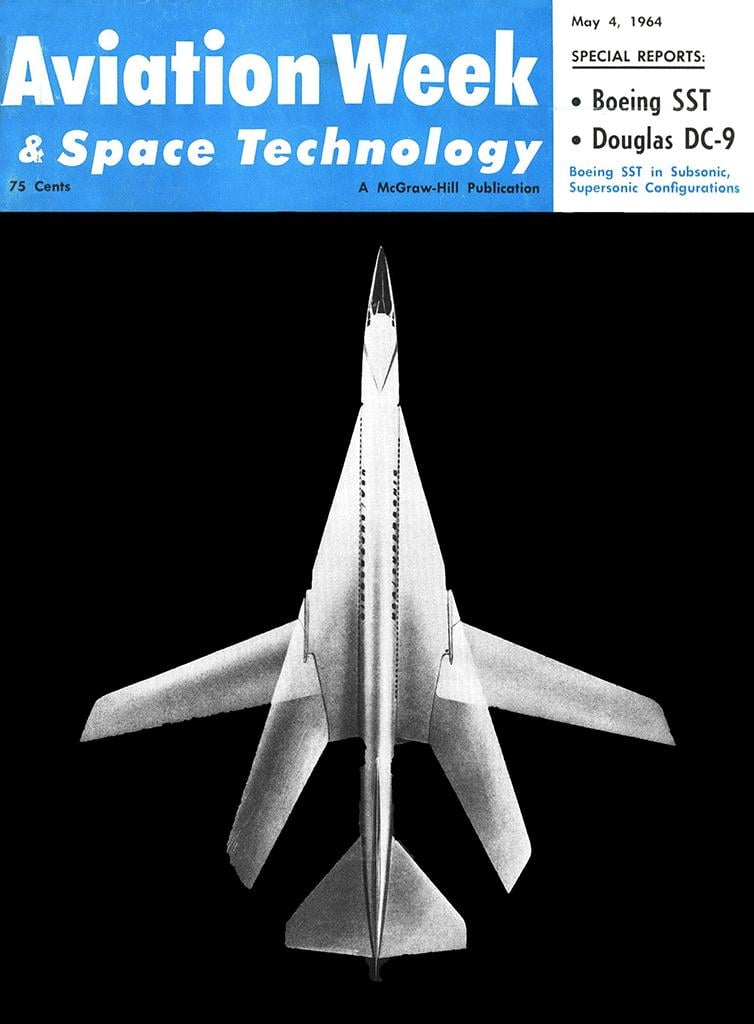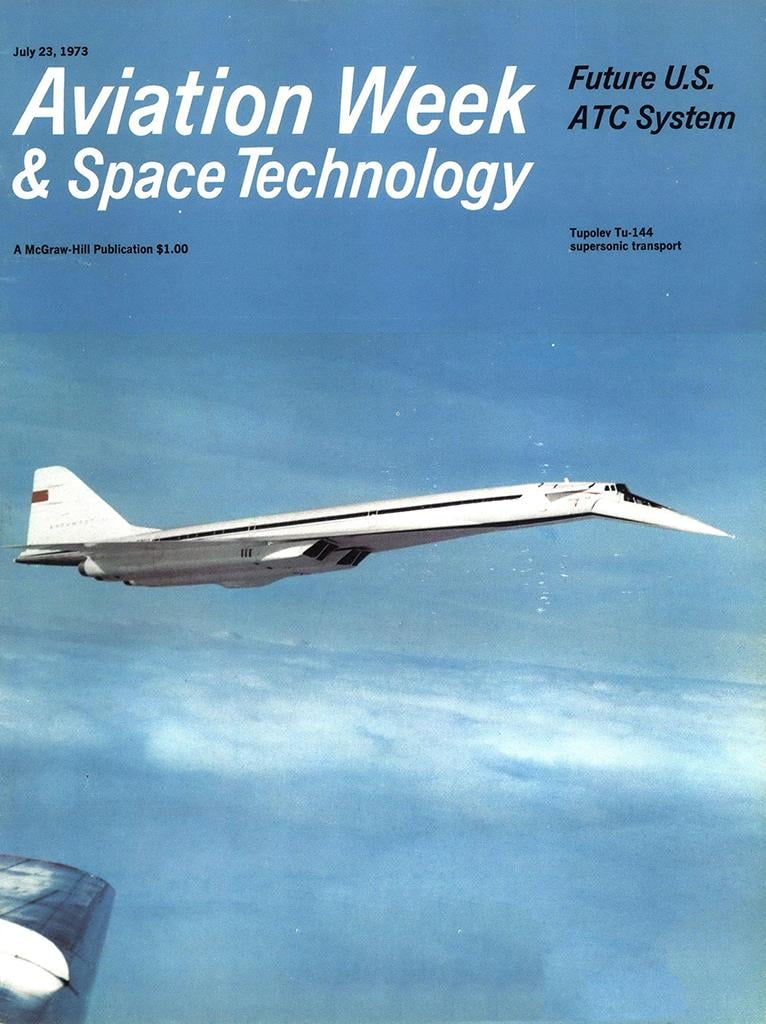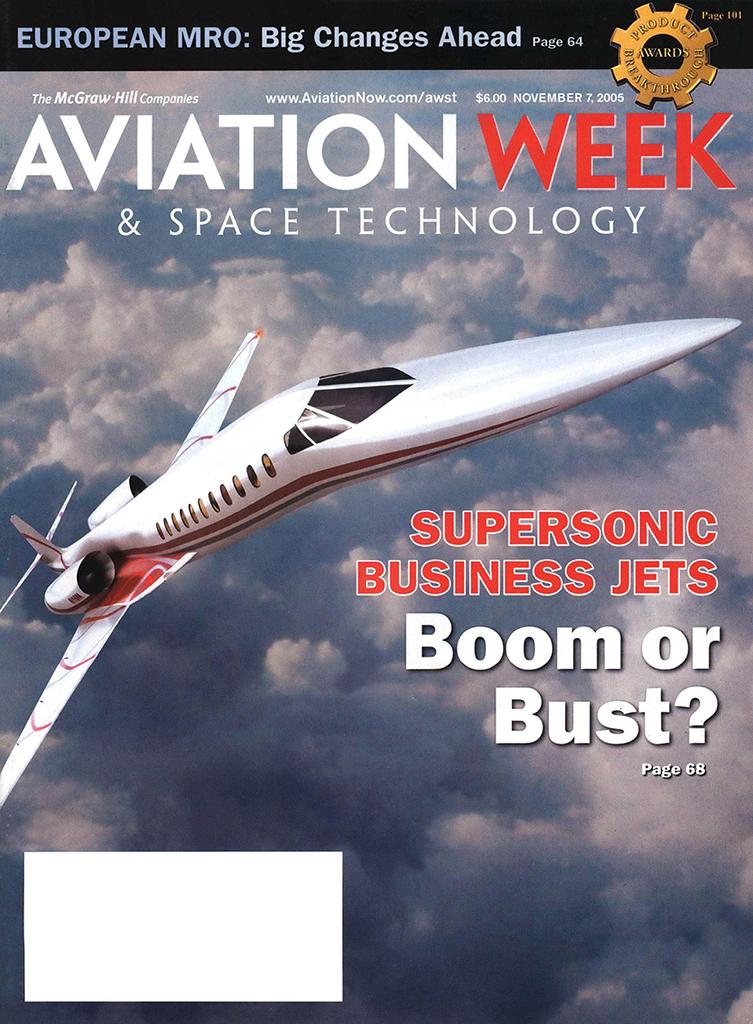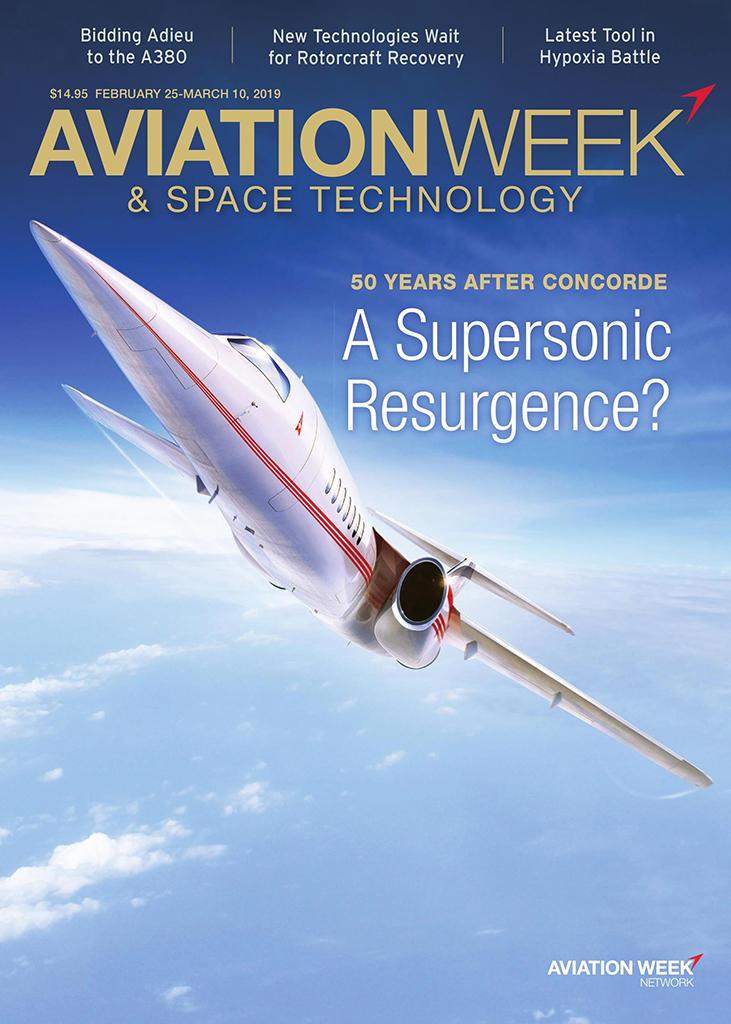
1964
This model of the Boeing 733 supersonic transport design proposal shows the variable-sweep wing in full-forward and fully swept configurations for subsonic and supersonic flight. Boeing proposed three different designs—the basic 733 for 150 passengers over a 4,030-mi. range, a domestic route version for 214 passengers over 2,880 mi., and an intercontinental route version for 214 passengers over 4,030 mi. Basic change would be a 45-ft. fuselage extension for the domestic and intercontinental designs.

1969
Spectators line a fence to watch Anglo-French Concorde supersonic transport prototype 001 take off from Toulouse-Blagnac Airport on its first flight on March 2, 1969. The aircraft lifted off from the’ runway after a 4,900-ft. takeoff roll and remained in flight for 28 min. Concorde made its second flight March 8. (The Concorde entered passenger service in 1976 but was never economically viable for large-scale operations. Service was discontinued in 2003, three years after an Air France Concorde crashed after striking a piece of debris during takeoff in Paris).

1971
This Class 3 engineering and manufacturing mock-up of the U.S. supersonic transport (SST), shown at Boeing Co.’s Seattle developmental center, is—the company believes—the most elaborate and precise aircraft mock-up ever built. Systems installation on the aluminum mock-up of the Model 2707-300 is more than 80% complete. (Two months after this cover was published, the U.S. Congress canceled the SST program.)

1973
A pre-production model of the Tupolev Tu-144 supersonic transport is shown during flight testing in the vicinity of Moscow. The Tu-144 was in series production at Voronezh, Russia, with an Aeroflot order for 30 aircraft required for services within the U.S. (After crashing in front of hundreds of thousands of spectators at the 1973 Paris Air Show, the Tu-144 entered passenger service in 1977. That was suspended less than a year later after the crash of a new variant during a flight test. The Tu-144 was used for cargo operations for several more years.)

1990
Our cover illustrates one possible advance in a high-speed civil transport under study at Boeing Commercial Airplanes. A 6 X 9-ft. model is shown in a low-speed wind tunnel at the University of Washington. The test of the high-lift system was part of Boeing’s internal preliminary design study for a supersonic transport.

1993
A 19-ft. High-Speed Research Program Reference-H Model, a current technical baseline configuration, had completed testing in the 14 X 22-ft. subsonic wind tunnel at NASA’s Langley Research Center.

2005
An artist’s illustration of a proposed supersonic business jet (SSBJ) under development by Aerion Corp. depicts the design in its latest configuration, following modifications made during the past year. Aerion officials were confident they could bring an SSBJ to market by 2011, but a CEO’s dream of flying faster than the speed of sound over land and sea faced serious technical and regulatory hurdles before it could become a reality.

2019
With Boeing a significant investor and GE Aviation, Spirit Aerosystems and Honeywell onboard as major supplier partners, business-jet developer Aerion looked to lead the return of supersonic air travel—one that would be economically and environmentally sustainable this time around. (Aerion went out of business in May 2021 after failing to raise money to continue operations.)

2021
Boom Supersonic’s breakthrough order from United Airlines for 15 Mach 1.7 Overture airliners put faster-than-sound travel back into the spotlight. Aviation Week editors reported on the United order and plans for Overture as well as the broader challenges facing developers of viable high-speed commercial transports.

2022
Proving the computational design tools for potential future low-boom supersonic aircraft is a vital prerequisite to unlocking the faster-than-sound civil market. Aviation Week Senior Editor Guy Norris explained why this schlieren image of the Lockheed Martin X-59 low-boom flight demonstrator model at Mach 1.4 in a NASA Glenn Research Center wind tunnel is a key step toward this goal.

1964
This model of the Boeing 733 supersonic transport design proposal shows the variable-sweep wing in full-forward and fully swept configurations for subsonic and supersonic flight. Boeing proposed three different designs—the basic 733 for 150 passengers over a 4,030-mi. range, a domestic route version for 214 passengers over 2,880 mi., and an intercontinental route version for 214 passengers over 4,030 mi. Basic change would be a 45-ft. fuselage extension for the domestic and intercontinental designs.

1969
Spectators line a fence to watch Anglo-French Concorde supersonic transport prototype 001 take off from Toulouse-Blagnac Airport on its first flight on March 2, 1969. The aircraft lifted off from the’ runway after a 4,900-ft. takeoff roll and remained in flight for 28 min. Concorde made its second flight March 8. (The Concorde entered passenger service in 1976 but was never economically viable for large-scale operations. Service was discontinued in 2003, three years after an Air France Concorde crashed after striking a piece of debris during takeoff in Paris).

1971
This Class 3 engineering and manufacturing mock-up of the U.S. supersonic transport (SST), shown at Boeing Co.’s Seattle developmental center, is—the company believes—the most elaborate and precise aircraft mock-up ever built. Systems installation on the aluminum mock-up of the Model 2707-300 is more than 80% complete. (Two months after this cover was published, the U.S. Congress canceled the SST program.)

1973
A pre-production model of the Tupolev Tu-144 supersonic transport is shown during flight testing in the vicinity of Moscow. The Tu-144 was in series production at Voronezh, Russia, with an Aeroflot order for 30 aircraft required for services within the U.S. (After crashing in front of hundreds of thousands of spectators at the 1973 Paris Air Show, the Tu-144 entered passenger service in 1977. That was suspended less than a year later after the crash of a new variant during a flight test. The Tu-144 was used for cargo operations for several more years.)

1990
Our cover illustrates one possible advance in a high-speed civil transport under study at Boeing Commercial Airplanes. A 6 X 9-ft. model is shown in a low-speed wind tunnel at the University of Washington. The test of the high-lift system was part of Boeing’s internal preliminary design study for a supersonic transport.

1993
A 19-ft. High-Speed Research Program Reference-H Model, a current technical baseline configuration, had completed testing in the 14 X 22-ft. subsonic wind tunnel at NASA’s Langley Research Center.

2005
An artist’s illustration of a proposed supersonic business jet (SSBJ) under development by Aerion Corp. depicts the design in its latest configuration, following modifications made during the past year. Aerion officials were confident they could bring an SSBJ to market by 2011, but a CEO’s dream of flying faster than the speed of sound over land and sea faced serious technical and regulatory hurdles before it could become a reality.

2019
With Boeing a significant investor and GE Aviation, Spirit Aerosystems and Honeywell onboard as major supplier partners, business-jet developer Aerion looked to lead the return of supersonic air travel—one that would be economically and environmentally sustainable this time around. (Aerion went out of business in May 2021 after failing to raise money to continue operations.)

2021
Boom Supersonic’s breakthrough order from United Airlines for 15 Mach 1.7 Overture airliners put faster-than-sound travel back into the spotlight. Aviation Week editors reported on the United order and plans for Overture as well as the broader challenges facing developers of viable high-speed commercial transports.

2022
Proving the computational design tools for potential future low-boom supersonic aircraft is a vital prerequisite to unlocking the faster-than-sound civil market. Aviation Week Senior Editor Guy Norris explained why this schlieren image of the Lockheed Martin X-59 low-boom flight demonstrator model at Mach 1.4 in a NASA Glenn Research Center wind tunnel is a key step toward this goal.
The Anglo-French Concorde and Russia’s Tupolev Tu-144 are the only two supersonic civil transports to have entered service—the Concorde from 1976 to 2003 and the Tu-144 from 1977 to 1978. Since the 1960s, there have been several high-speed projects and research initiatives in the U.S., but so far none have come to fruition. They have all been dutifully covered by Aviation Week, as you’ll see in the following slides. Don’t miss our accompanying Check 6 podcast, where Aviation Week Editors Graham Warwick and Guy Norris discuss NASA’s recent contract awards to Boeing to study technology for high-speed airliners flying faster than Mach 2—and the one supersonic project that is still pushing forward, Boom Supersonic.











